Stratigraphy, Paleogeography and Depositional Setting of the K–Mg Salts in the Zechstein Group of Netherlands—Implications for the Development of Salt Caverns
Abstract
:1. Introduction
2. Geological Setting
2.1. Tectono-Stratigraphic Setting
2.2. Stratal Architecture of the Zechstein group in Netherland—State of the Art
2.2.1. Z1—Werra Fm
2.2.2. Z2—Stassfurt Fm
2.2.3. Z3—Leine Fm
2.2.4. Z4—Aller Fm
2.2.5. Z5—Ohre Fm
3. Materials and Methods
4. Results: Stratal Evolution and Facies Repartition the Zechstein Salt Units
4.1. Z1 Salt Unit
4.2. Z2 Salt Unit

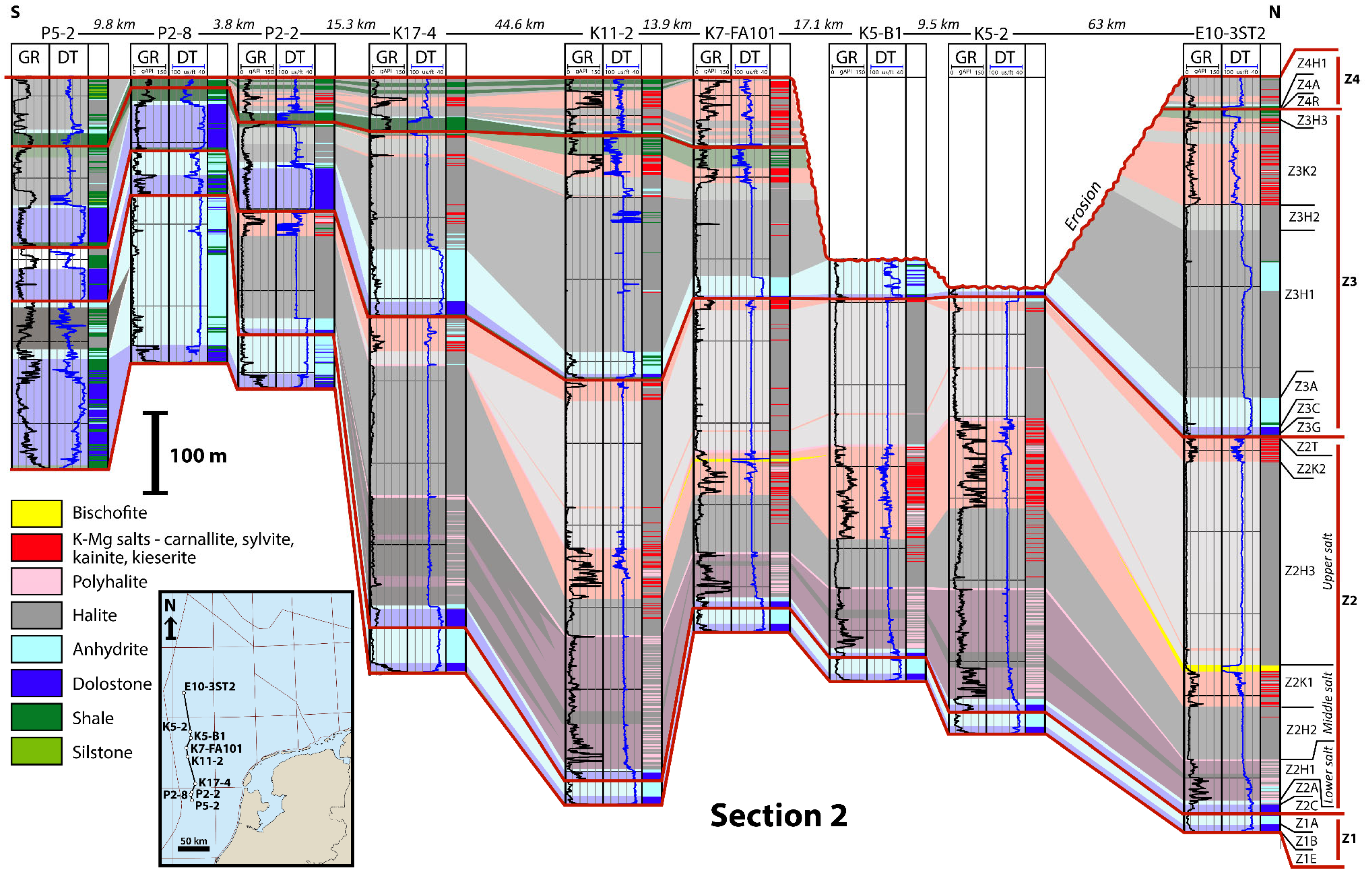
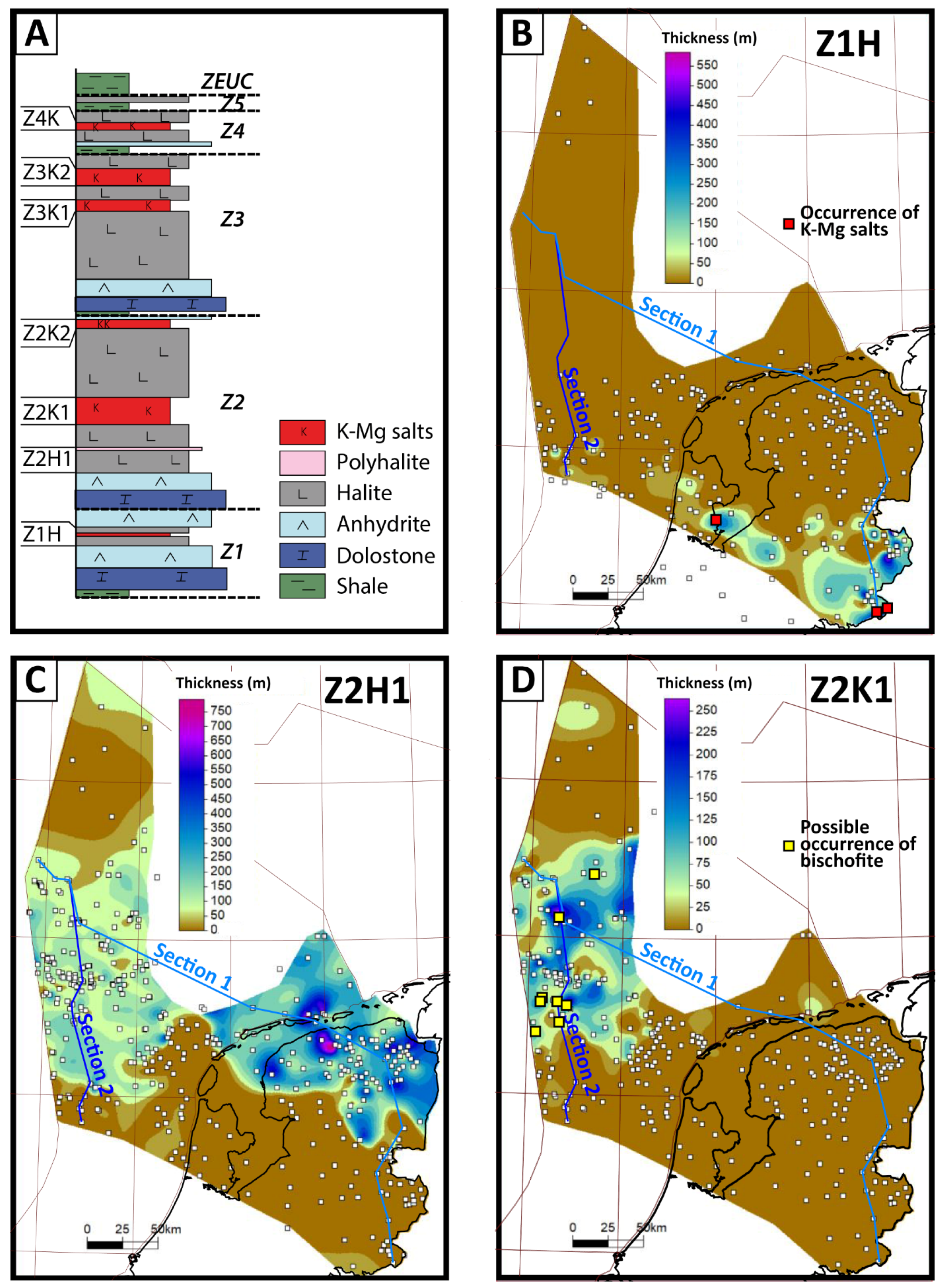
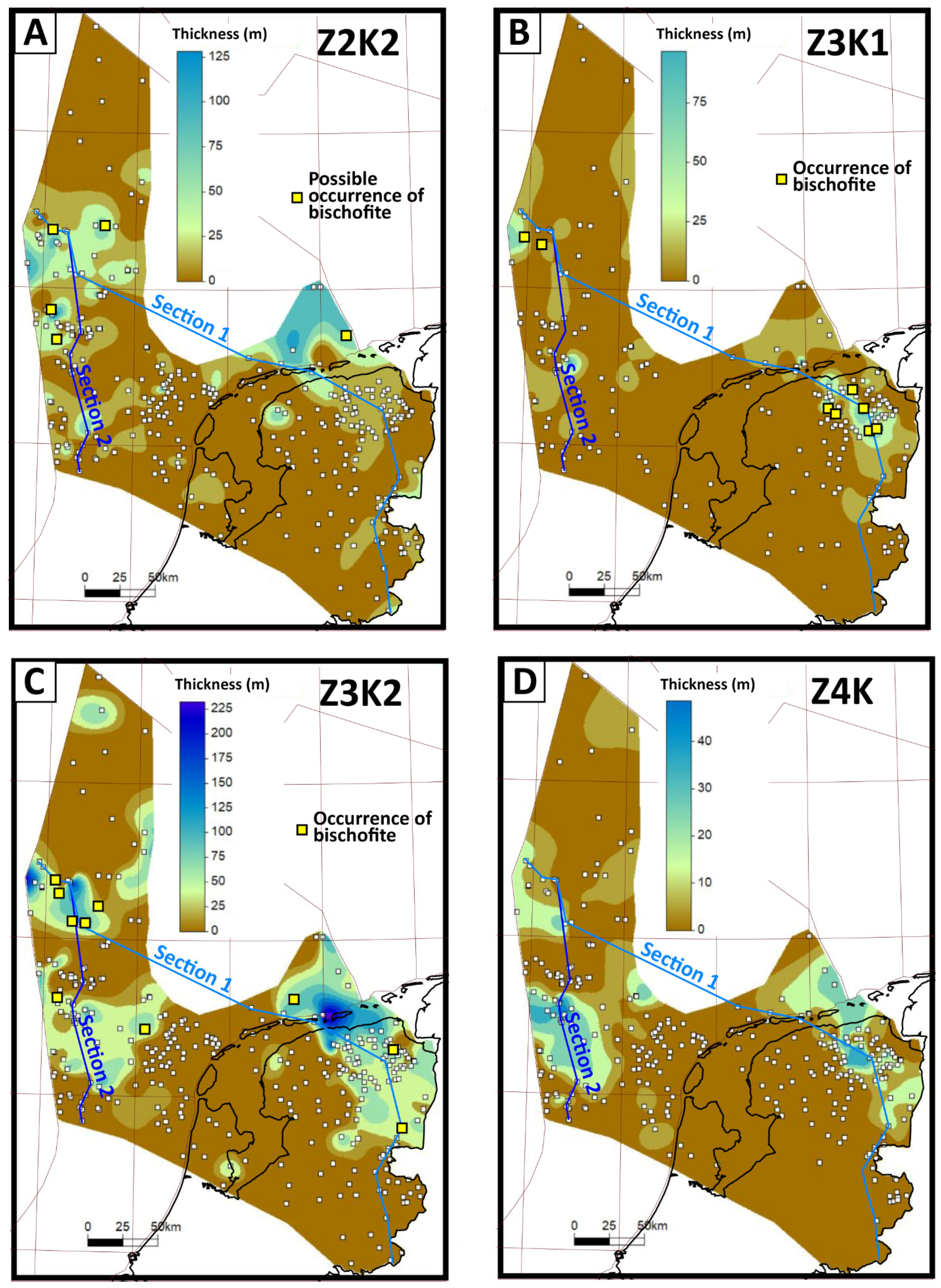
4.3. Z3 Salt Unit
4.4. Z4 Salt Unit
5. Discussion
5.1. Controlling Factors of the Stratal Evolution in the Z2, Z3 and Z4 Salt Units
5.1.1. Origin of Thickness Variations in the Z2H1 and Z2H2 Units
5.1.2. Origin of the Anhydrite and Polyhalite Layers in the Z2H1
5.1.3. Depositional Setting of the Z2, Z3 and Z4 K–Mg Salts Deposits
5.2. Implications and Recommendation for the Development of Salt Caverns in the Zechstein Group
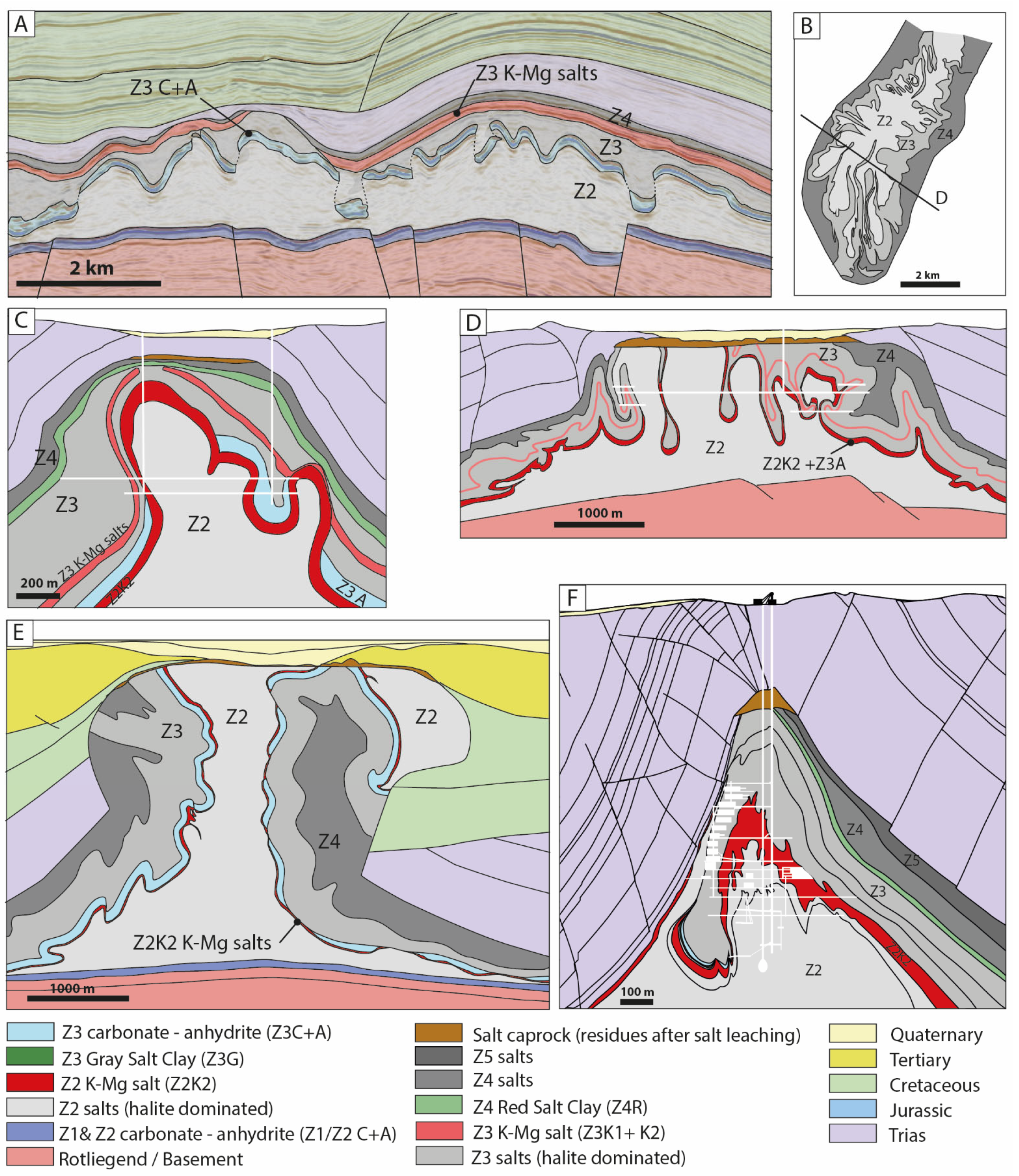
6. Conclusions
- -
- Each Zechstein evaporite cycle (Z1 to Z4) includes one to two intervals rich in K–Mg salts which were named Z1K, Z2K1, Z2K2, Z3K1, Z3K2 and Z4K.
- -
- The Z1K was spatially limited to the tectonically controlled deepest depocenters of the Z1 salt unit.
- -
- During the first halite precipitation stage of the Z2, deep hydrological conditions coupled with marine freshwater influxes sourced from the northwest induced a higher precipitation rate of halite in the eastern onshore domain of Netherlands, resulting in the development of a 200 m thick halite platform. Basin-ward, the halite was ~100 m thick and interlayered with primary to secondary polyhalite and anhydrite, some of which were also turbidite deposits sourced from the marginal Z2 anhydrite platform.
- -
- The Z2K1 accumulated from relatively deep to shallow water conditions in the distal topographic low created during the previous halite saturation stage, i.e., north of the halite platform which was emerged during the maximum drawdown.
- -
- The Z2K2, Z3K1, Z3K2 and Z4K had a more regional extension as they rather developed on a very flat basin, under shallow water to subaerial conditions marked by a mosaic of depocenters, some of which had been controlled by tectonic activity and related salt movements.
- -
- Wireline log data suggest that the four K–Mg-rich intervals in the Z2 and Z3 include local occurrences of bischofite developed in perennial subaqueous and hypersaline conditions, in the deepest depocenters around which complete desiccation probably occurred.
- -
- Finally, the constrained spatial repartition of the K–Mg salts in the Zechstein group, coupled with the structural characterization of the halokinetic deformations, enable us to assess the risk of encountering K–Mg rich salts in salt structures eligible in term of depth and thickness for the development of salt caverns.
- -
- The updated litho-stratigraphic architecture of the Zechstein group in Netherlands could be useful for other industrial purposes, such as oil and gas drilling operations or for the mining and leaching of K–Mg salts.
Funding
Data Availability Statement
Acknowledgments
Conflicts of Interest
References
- McKie, T.; Soto, J.I.; Flinch, J.F.; Tari, G. Paleogeographic evolution of latest Permian and Triassic salt basin in Northwest Europe. In Permo-Triassic Salt Provinces of Europe, North Africa and the Atlantic Margins: Tectonics and Hydrocarbon Potential; Soto, J.I., Flinch, J., Tari, G., Eds.; Elsevier: Amsterdam, The Netherlands, 2017; pp. 159–173. ISBN 9780128114506. [Google Scholar]
- Stollhofen, H.; Bachmann, G.H.; Barnasch, J.; Bayer, U.; Beutler, G.; Franz, M.; Kaestner, M.; Legler, B.; Mutterlose, J.; Radies, D. Upper Rotliegend to Early Cretaceous Basin Development. In Dynamics of Complex Intracontinental Basins: The Central European Basin System; Littke, R., Bayer, U., Gajewski, D., Nelskamp, S., Eds.; Springer: Berlin/Heidelberg, Germany, 2008; pp. 181–210. [Google Scholar]
- Soto, J.I.; Flinch, J.; Tari, G. Permo-Triassic Basins and Tectonics in Europe, North Africa and the Atlantic Margins: A Synthesis. In Permo-Triassic Salt Provinces of Europe, North Africa and the Atlantic Margins: Tectonics and Hydrocarbon Potential; Soto, J.I., Flinch, J., Tari, G., Eds.; Elsevier: Amsterdam, The Netherlands, 2017; pp. 3–41. ISBN 9780128114506. [Google Scholar]
- Geluk, M.C. Permian. In Geology of the Netherlands; Wong, T.E., Batjes, D.A.J., Jager, J., de van Wetenschappen, K.N.A., Eds.; Royal Netherlands Academy of Arts and Sciences: Amsterdam, The Netherlands, 2007; pp. 63–83. [Google Scholar]
- Duin, E.J.T.; Doornenbal, J.C.; Rijkers, R.H.B.; Verbeek, J.W.; Wong, T.E. Subsurface structure of the Netherlands-results of recent onshore and offshore mapping. Neth. J. Geosci. 2006, 85, 245–276. [Google Scholar] [CrossRef] [Green Version]
- Biehl, B.C.; Reuning, L.; Strozyk, F.; Kukla, P.A. Origin and deformation of intra-salt sulphate layers: An example from the Dutch Zechstein (Late Permian). Int. J. Earth Sci. 2014, 103, 697–712. [Google Scholar] [CrossRef] [Green Version]
- Raith, A.F.; Urai, J.L.; Visser, J. Structural and microstructural analysis of K-Mg salt layers in the Zechstein 3 of the Veendam Pillow, NE Netherlands: Development of a tectonic mélange during salt flow. Geol. En Mijnb. Neth. J. Geosci. 2017, 96, 331–351. [Google Scholar] [CrossRef] [Green Version]
- Geluk, M.C. Stratigraphy and tectonics of Permo-Triassic basins in the Netherlands and surrounding areas. Doctoral Dissertation, University Utrecht, Heidelberglaan, Utrecht, 2007. [Google Scholar]
- Harvie, C.E.; Weare, J.H.; Hardie, L.A.; Eugster, H.P. Evaporation of sea water; calculated mineral sequences. Science 1980, 208, 498–500. [Google Scholar] [CrossRef]
- Pletsch, T.; Appel, J.; Botor, D.; Clayton, C.; Duin, E.; Faber, E.; Górecki, W.; Kombrink, H.; Kosakowski, P.; Kuper, G.; et al. Petroleum genereation and migration. In Petroleum Geological Atlas of the Southern Permian Basin Area; Doornenbal, H., Stevenson, A., Eds.; EAGE Publications b.v: Houten, The Netherlands, 2010; pp. 225–253. [Google Scholar]
- Garrett, D.E. Potash: Deposits, Processing, Properties and Uses; Chapman & Hall: London, UK, 1996; ISBN 9789401071895. [Google Scholar]
- Geluk, M.C.; Paar, W.A.; Fokker, P.A. Salt. In Geology of The Netherlands; Wong, T.E., Batjes, D.A.J., Jager, J., de van Wetenschappen, K.N.A., Eds.; Royal Netherlands Academy of Arts and Sciences: Amsterdam, The Netherlands, 2007; pp. 283–294. [Google Scholar]
- Coelewij, P.; Haug, G.; van Kuijk, H. Magnesium-salt exploration in the northeastern Netherlands. Geol Mijnb. 1978, 57, 487–502. [Google Scholar]
- van Adrichem Boogaert, H.A.; Kouwe, W.F.P. Stratigraphic nomenclature of the Netherlands; revision and update by RGD and NOGEPA, Section D Permian. Mededelingen Rijks Geologische Dienst. 1994, 50, 1–42. [Google Scholar]
- Hoelen, Q.; van Pijkeren, G.; Teuben, B.; Steenbergen, B.; Breuning, P. Gas Storage in salt caverns—“Aardgasbuffer Zuidwending”—The Netherlands. In Proceedings of the 23rd World Gas Conference, Amsterdam, The Netherlands, 5–9 June 2006; pp. 1–12. [Google Scholar]
- Juez-Larré, J.; van Gessel, S.; Dalman, R.; Remmelts, G.; Groenenberg, R. Assessment of underground energy storage potential to support the energy transition in the Netherlands. First Break 2019, 37, 57–66. [Google Scholar] [CrossRef]
- Lankof, L.; Tarkowski, R. Assessment of the potential for underground hydrogen storage in bedded salt formation. Int. J. Hydrog. Energy 2020, 45, 19479–19492. [Google Scholar] [CrossRef]
- Caglayan, D.G.; Weber, N.; Heinrichs, H.U.; Linßen, J.; Robinius, M.; Kukla, P.A.; Stolten, D. Technical potential of salt caverns for hydrogen storage in Europe. Int. J. Hydrog. Energy 2020, 45, 6793–6805. [Google Scholar] [CrossRef]
- Da Costa, A.M.; Costa, P.V.; Miranda, A.C.; Goulart, M.B.; Udebhulu, O.D.; Ebecken, N.F.; Azevedo, R.C.; Eston, S.M.; de Tomi, G.; de Mendes, A.B.; et al. Experimental salt cavern in offshore ultra-deep water and well design evaluation for CO2 abatement. Int. J. Min. Sci. Technol. 2019, 29, 641–656. [Google Scholar] [CrossRef]
- Barnett, H.; Ireland, M.T.; Acikalin, S. Assessing the Feasibility of Large-Scale Hydrogen Storage in Salt Caverns on the UKCS Using 3D Seismic Data. In Proceedings of the EGU General Assembly Conference Abstracts, Vienna, Austria, 19–30 April 2021. [Google Scholar]
- Eradus, D.S. The Techno-Economic Feasibility of Green Hydrogen Storage in Salt Caverns in the Dutch North Sea. Master’s Thesis, Delft University of Technology, Delft, The Netherlands, 2022. [Google Scholar]
- Hassanpouryouzband, A.; Joonaki, E.; Edlmann, K.; Haszeldine, R.S. Offshore Geological Storage of Hydrogen: Is This Our Best Option to Achieve Net-Zero? ACS Energy Lett. 2021, 6, 2181–2186. [Google Scholar] [CrossRef]
- Ozarslan, A. Large-scale hydrogen energy storage in salt caverns. Int. J. Hydrog. Energy 2012, 37, 14265–14277. [Google Scholar] [CrossRef]
- Warren, J.K. Evaporites: A Geological Compendium; Springer: Berlin/Heidelberg, Germany, 2016; ISBN 978-3-319-13512-0. [Google Scholar]
- Allen, R.D.; Doherty, T.J.; THoms, R.L. Geotechnical Factors and Guidelines for Storage of Compressed Air in Solution Mined Salt Cavities; No. PNL-4242, 1982; Pacific Northwest Lab: Richland, WA, USA, 1982. [Google Scholar]
- Xue, T.; Yang, C.; Shi, X.; Hongling, M.; Li, Y.; Ge, X.; Liu, X. The formation mechanism of irregular salt caverns during solution mining for natural gas storage. Energy Sources Part A Recovery Util. Environ. Eff. 2020, 1–17. [Google Scholar] [CrossRef]
- Jackson, C.A.L.; Jackson, M.P.; Hudec, M.R.; Rodriguez, C.R. Enigmatic structures within salt walls of the Santos Basin-Part 1: Geometry and kinematics from 3D seismic reflection and well data. J. Struct. Geol. 2015, 75, 135–162. [Google Scholar] [CrossRef] [Green Version]
- Dooley, T.P.; Jackson, M.P.; Jackson, C.A.; Hudec, M.R.; Rodriguez, C.R. Enigmatic structures within salt walls of the Santos Basin—Part 2: Mechanical explanation from physical modelling. J. Struct. Geol. 2015, 75, 163–187. [Google Scholar] [CrossRef] [Green Version]
- Stewart, S.A.; Clark, J.A. Impact of salt on the structure of the Central North Sea hydrocarbon fairways. In Petroleum Geology of Nortwest Europe: Proceeding of the 5th Conference; Fleet, A.J., Boldy, S.A.R., Eds.; Geological Society: London, UK, 1999; pp. 179–200. [Google Scholar]
- Taylor, J. Upper Permian—Zechstein. In Petroleum Geology of the North Sea: Basic Concepts and Recent Advances; Glennie, K.W., Ed.; John Wiley & Sons: Hoboken, NJ, USA, 1998; pp. 174–212. [Google Scholar]
- Raith, A.F.; Strozyk, F.; Visser, A.F.; Urai, J.L. Evolution of rheologically heterogeneous salt structures: A case study from the NE Netherlands. Solid Earth 2016, 7, 67–82. [Google Scholar] [CrossRef] [Green Version]
- Harding, R.; Huuse, M. Salt on the move: Multi stage evolution of salt diapirs in the Netherlands North Sea. Mar. Pet. Geol. 2015, 61, 39–55. [Google Scholar] [CrossRef]
- Mohr, M.; Kukla, P.A.; Urai, J.L.; Bresser, G. Multiphase salt tectonic evolution in NW Germany: Seismic interpretation and retro-deformation. Int. J. Earth Sci. 2005, 94, 917–940. [Google Scholar] [CrossRef]
- Geluk, M.C.; Rohling, H.G. High-resolution sequence stratigraphy of the Lower Triassic ’Buntsandstein’ in the Netherlands and northwestern Germany. Geol. Mijnb. 1997, 76, 227–246. [Google Scholar] [CrossRef]
- Geluk, M.C. Late Permian (Zechstein) carbonate-facies maps, the Netherlands. Geol. En Mijnb. 2000, 79, 17–27. [Google Scholar] [CrossRef] [Green Version]
- Barabasch, J.; Urai, J.L.; Raith, A.F.; de Jager, J. The early life of a salt giant: 3D seismic study on syntectonic zechstein salt and stringer deposition on the Friesland platform, Netherlands. Z. Der Dtsch. Ges. Fur Geowiss. 2019, 170, 1–16. [Google Scholar] [CrossRef]
- Dyjaczyński, K.; Peryt, T.M. Controls on basal Zechstein (Wuchiapingian) evaporite deposition in SW Poland. Geol. Q. 2014, 58, 475–492. [Google Scholar] [CrossRef]
- Betzler, C.; Pawellek, T. Facies, stratigraphic architecture and high-resolution sequence stratigraphy of the Zechstein anhydrite (Werra Anhydrite) in Menslage area (Lower Saxony, N Germany). Z. Der Dtsch. Ges. Für Geowiss. 2014, 165, 331–344. [Google Scholar] [CrossRef]
- Mawson, M.; Tucker, M. High-frequency cyclicity (Milankovitch and millennial-scale) in slope-apron carbonates: Zechstein (Upper Permian), North-east England. Sedimentology 2009, 56, 1905–1936. [Google Scholar] [CrossRef]
- van de Sande, J.M.M. Prediction of Reservoir Parameters from 3-D Seismic Data for the Zechstein 2 Carbonate Play in the Northeast Netherlands. In AAPG Studies in Geology No. 42 and SEG Geophysical Developments Series No. 5; Weimer, P., Davis, T.L., Eds.; AAPG/SEG: Tusla, OK, USA, 1996; pp. 197–204. [Google Scholar]
- Reijers, T.J.A. Sedimentology and diagenesis as ’hydrocarbon exploration tools’ in the Late Permian Zechstein-2 Carbonate Member (NE Netherlands). Geologos 2012, 18, 163–195. [Google Scholar] [CrossRef]
- Grant, R.J.; Underhill, J.R.; Hernández-Casado, J.; Barker, S.M.; Jamieson, R.J. Upper Permian Zechstein Supergroup carbonate-evaporite platform palaeomorphology in the UK Southern North Sea. Mar. Pet. Geol. 2019, 100, 484–518. [Google Scholar] [CrossRef]
- Becker, F.; Bechstädt, T. Sequence stratigraphy of a carbonate-evaporite succession (Zechstein 1, Hessian Basin, Germany). Sedimentology 2006, 53, 1083–1120. [Google Scholar] [CrossRef]
- Menning, M.; Alekseev, A.S.; Chuvashov, B.I.; Davydov, V.I.; Devuyst, F.X.; Forke, H.C.; Grunt, T.A.; Hance, L.; Heckel, P.H.; Izokh, N.G.; et al. Global time scale and regional stratigraphic reference scales of Central and West Europe, East Europe, Tethys, South China, and North America as used in the Devonian-Carboniferous-Permian Correlation Chart 2003 (DCP 2003). Palaeogeogr. Palaeoclimatol. Palaeoecol. 2006, 240, 318–372. [Google Scholar] [CrossRef]
- De Jager, J.; Visser, C. Geology of the Groningen field–an overview. Neth. J. Geosci. 2017, 96, s3–s15. [Google Scholar] [CrossRef] [Green Version]
- van Wees, J.D.; Stephenson, R.A.; Ziegler, P.A.; Bayer, U.; Mccann, T.; Dadlez, R.; Gaupp, R.; Narkiewicz, M.; Bitzer, F.; Scheck, M. On the origin of the Southern Permian Basin, Central Europe. Mar. Pet. Geol. 2000, 17, 43–59. [Google Scholar] [CrossRef]
- Rijkers, R.; Geluk, M.C. Sedimentary and structural history of the Texel-IJsselmeer High, the Netherlands. In Geology of Gas and Oil under the Netherlands: Selection of Papers Presented at the 1993 International Conference of the American Association of Petroleum Geologists, Held in The Hague; Rondeel, H.E., Batjes, D., Nieuwenhuijs, W.H., Eds.; Springer: Berlin/Heidelberg, Germany, 1996; pp. 265–284. [Google Scholar]
- Schroot, B.M.; de Haan, H.B. An improved regional structural model of the Upper Carboniferous of the Cleaver Bank High based on 3D seismic interpretation. Geol. Soc. Spec. Publ. 2003, 212, 23–37. [Google Scholar] [CrossRef]
- Scheck-Wenderoth, M.; Lamarche, J. Crustal memory and basin evolution in the Central European Basin System—New insights from a 3D structural model. Tectonophysics 2005, 397, 143–165. [Google Scholar] [CrossRef]
- Gast, R.E.; Dusar, M.; Breitkreuz, C.; Gaupp, R.; Schneider, J.W.; Stemmerik, L.; Geluk, M.C.; Geißler, M.; Kiersnowski, H. Rotliegend. In Petroleum Geological Atlas of the Southern Permian Basin Area; Doornenbal, H., Stevenson, A., Eds.; EAGE Publications b.v: Houten, The Netherlands, 2010; pp. 101–121. [Google Scholar]
- Menning, M. A numerical timescale for the Permian and Triassic periods: An integrated time analysis. In The Permian of Northern Pangea; Scholle, P., Peryt, T., Ulmer-Scholle, D.S., Eds.; Springer: Berlin/Heidelberg, Germany, 1995; pp. 77–97. [Google Scholar]
- Menning, M.; Gast, R.; Hagdorn, H.; Käding, K.C.; Simon, T.; Szurlies, M.; Nitsch, E. Zeitskala für Perm und Trias in der Stratigraphischen Tabelle von Deutschland 2002, zyklostratigraphische Kalibrierung der höheren Dyas und Germanischen Trias und das Alter der Stufen Roadium bis Rhaetium 2005. Newsl. Stratigr. 2006, 41, 174–210. [Google Scholar] [CrossRef]
- Denison, R.E.; Peryt, T.M. Strontium isotopes in the Zechstein anhydrites of Poland: Evidence of varied meteoric contributions to marine brines. Geol. Q. 2009, 53, 159–166. [Google Scholar]
- Remmelts, G. Fault-related salt tectonics in the Southern North Sea, The Netherlands. In Salt Tectonics: A global Perspective; Jackson, M., Roberts, D.G., Snelson, S., Eds.; Memoir 65; American Association or Petroleum Geologists: Tulsa, OK, USA, 1995; pp. 261–272. [Google Scholar]
- Tucker, M.E. Sequence stratigraphy of carbonate-evaporite basins: Models and application to the Upper Permian (Zechstein) of northeast England and adjoining North Sea. J. Geol. Soc. 1991, 148, 1019–1036. [Google Scholar] [CrossRef]
- Goodall, I.G.; Harwood, G.M.; Kendall, A.C.; McKie, T.; Tucker, M.E. Discussion on sequence stratigraphy of carbonate-evaporite basins: Models and application to the Upper Permian (Zechstein) of northeast England and adjoining North Sea. J. Geol. Soc. 1992, 149, 1050–1054. [Google Scholar] [CrossRef]
- Mitchum, R.M.; van Wagoner, J.C. High-frequency sequences and their stacking patterns: Sequence-stratigraphic evidence of high-frequency eustatic cycles. Sediment. Geol. 1991, 70, 131–160. [Google Scholar] [CrossRef]
- Peryt, T.M.; Geluk, M.C.; Mathiesen, A.; Paul, J.; Smith, K. Zechstein. In Petroleum Geological Atlas of the Southern Permian Basin Area; EAGE Publications b.v: Houten, The Netherlands, 2010. [Google Scholar]
- NITG. Geological Atlas of the Subsurface of The Netherlands, Explanation to Map Sheet X Almelo–Winterswijk (1:250,000); Netherlands Institute for Applied Geoscience TNO—National Geological Survey: Amsterdam, The Netherlands, 1998. [Google Scholar]
- Geluk, M.C.; Plomp, A.; van Doorn, T.H. Development of the Permo-Triassic succession in the basin fringe area, southern Netherlands. In Geology of Gas and Oil under The Netherlands: Selection of Papers Presented at the 1993 International Conference of the American Association of Petroleum Geologists, held in The Hague; Rondeel, H.E., Batjes, D.A.J., Nieuwenhuijs, W.H., Eds.; Springer Science & Business Media: Dordrecht, Germany, 1996; pp. 57–78. [Google Scholar]
- Strohmenger, C.; Antonini, M.; Jäger, G.; Rockenbauch, K.; Strauss, C. Zechstein 2 carbonate reservoir facies distribution in relation to zechstein sequence stratigraphy (upper Permian, northwest Germany): An integrated approach. Bull. Des Cent. De Rech. Elf Explor. Prod. 1996, 20, 1–35. [Google Scholar]
- van den Belt, F.J.G.; de Boer, P.L. An intra-basinal Mechanism for marine-evaoprite cyclicity. J. Geol. Soc. Lond. 2014, 171, 461–464. [Google Scholar] [CrossRef]
- van den Belt, F.J.; de Boer, P.L. A shallow-basin model for ‘saline giants’ based on isostasy-driven subsidence. In Sedimentary Processes, Environments and Basins: A Tribute to Peter Friend; Nichols, G., Williams, E., Paola, C., Eds.; John Wiley & Sons: Hoboken, NJ, USA, 2009; pp. 241–252. [Google Scholar]
- Geluk, M. Late Permian (Zechstein) rifting in the Netherlands: Models and implications for petroleum geology. Pet. Geosci. 1999, 5, 189–199. [Google Scholar] [CrossRef]
- TNO-GDN. Z5 Salt Member, 2022. Stratigraphic Nomenclature of The Netherlands, TNO—Geological Survey of The Netherlands. Available online: http://www.dinoloket.nl/en/stratigraphic-nomenclature/z5-salt-member (accessed on 4 February 2022).
- Hirlemann, G. Pendagemétrie directe et indirecte—Comparaison et contribution à la résolution de la gîtologie des niveaux sylvinitiques dans la série du bassin côtier congolais. Géologues 1993, 100–101, 42–48. [Google Scholar]
- Sarg, J.F. The sequence stratigraphy, sedimentology, and economic importance of evaporite±carbonate transitions: A review. Sediment. Geol. 2001, 140, 9–42. [Google Scholar] [CrossRef]
- Sirota, I.; Ouillon, R.; Mor, Z.; Meiburg, E.; Enzel, Y.; Arnon, A.; Lensky, N.G. Hydroclimatic Controls on Salt Fluxes and Halite Deposition in the Dead Sea and the Shaping of “Salt Giants”. Geophys. Res. Lett. 2020, 47, e2020GL090836. [Google Scholar] [CrossRef]
- Clark, J.A.; Stewart, S.A.; Cartwright, J.A. Evolution of the NW margin of the North Permian Basin, UK North Sea. J. Geol. Soc. 1998, 155, 663–676. [Google Scholar] [CrossRef]
- Martins, G.S.; Mohriak, W.U.; Destro, N. Synrift evaporite deposition and structural characterization of the onshore Alagoas subbasin. Interpretation 2019, 7, 19–31. [Google Scholar] [CrossRef]
- Colter, V.S.; Reed, G.E. Zechstein 2 Fordon Evaporite of the Atwick No. 1 borehole, surrounding areas of the N.E England and the adjacent southern North Sea. In The Zechstein Basin with Emphasis on Carbonate Sequences, 9th ed.; Füchtbauer, H., Peryt, T.M., Eds.; Schweizerbart: Stuttgart, Germany, 1980; pp. 115–129. [Google Scholar]
- Taylor, J.C.M.; Colter, V.S. Zechstein of the English sector of the Southern North Sea Basin. In Petroleum and the Continental Shelf of North West Europe: Volum 1: Geology; Woodland, A.W., Ed.; Applied Science Publishers Ltd: Barking, Essex, 1975; pp. 249–263. [Google Scholar]
- Hovorka, S.; Nava, R. Characterization of bedded salt for storage caverns-A case study from the Midland Basin, Texas. Natl. Pet. Technol. Off. Tulsa OK (US); No. DOE/BC; National Energy Technology Lab: Tulsa, OK, USA, 2000. [Google Scholar]
- Raup, O.B.; Hite, R.J. Lithology of Evaporite Cycles and Cycle Boundaries in the Upper Part of the Paradox Formation of the Hermosa Group of Pennsylvanian Age in the Paradox Basin, Utah and Colorado; US Government Printing Office: Washington, DC, USA, 1992.
- Sirota, I.; Enzel, Y.; Lensky, N.G. Halite focusing and amplification of salt layer thickness: From the Dead Sea to deep hypersaline basins. Geol. Soc. Am. 2018, 2, 851–854. [Google Scholar] [CrossRef]
- Kovalevych, V.M.; Peryt, T.M.; Shanina, S.N. Geochemical aureoles around oil and- gas accumulations in the Zechstein (Upper Permian) of Poland: Analysis of fluid inclusions in halite and bitumens in salt. J. Pet. Geol. 2008, 31, 245–262. [Google Scholar] [CrossRef]
- Peryt, T.M.; Kasprzyk, A.; Czapowski, G. Basal Anhydrite and Screening Anhydrite (Zechstein, Upper Permian) in Poland. Bull. Pol. Acad. Sci. 1996, 44, 131–134. [Google Scholar]
- Kasprzyk, A. Sedimentological and diagenetic patterns of anhydrite deposits in the Badenian evaporite basin of the Carpathian Foredeep, southern Poland. Sediment. Geol. 2003, 158, 167–194. [Google Scholar] [CrossRef]
- Pichat, A.; Hoareau, G.; Callot, J.-P.; Ringenbach, J.-C. Characterization of Oligo-Miocene evaporite-rich minibasins in the Sivas Basin, Turkey. Mar. Pet. Geol. 2019, 110, 587–605. [Google Scholar] [CrossRef]
- Schreiber, B.C.; Helman, M.L. Criteria for Distinguishing Primary Evaporite Features from Deformation Features in Sulfate Evaporites. J. Sediment. Res. 2005, 75, 960–963. [Google Scholar] [CrossRef]
- Da Gong, X.; Xiao, B.; Bagas, L.; Li, D.; Zhou, J.Y.; Zou, H. Origin of the Early to Middle Triassic polyhalite minerals in the Sichuan Basin, SW China: New evidence from calcium and sulphur isotopes and microfabrics. Ore Geol. Rev. 2021, 139, 104439. [Google Scholar] [CrossRef]
- Steward, F.H. The Permian lower evaporites of Fordon in Yorkshire. Proc. Yorks. Geol. Soc. 1963, 34, 1–44. [Google Scholar] [CrossRef]
- Shang, W.J.; Zheng, M.P.; Zhang, Y.S.; Zhong, J.A.; Xing, E.Y.; Peng, Y.; Gui, B.L.; Li, K. Characteristics and origin of a new type of polyhalite potassium ore in the Lower Triassic Jialingjiang Formation, Puguang area, northeastern Sichuan Basin, SW China. J. Palaeogeogr. 2021, 10, 1–13. [Google Scholar] [CrossRef]
- Peryt, T.M.; Pierre, C.; Gryniv, S.P. Origin of polyhalite deposits in the Zechstein (Upper Permian) Zdrada platform (northern Poland). Sedimentology 1998, 45, 565–578. [Google Scholar] [CrossRef]
- Peryt, T.M.; Tomassi-Morawiec, H.; Czapowski, G.; Hryniv, S.P.; Pueyo, J.J.; Eastoe, C.J.; Vovnyuk, S. Polyhalite occurrence in the Werra (Zechstein, Upper Permian) peribaltic basin of Poland and Russia: Evaporite facies constraints. Carbonates Evaporites 2005, 20, 182–194. [Google Scholar] [CrossRef]
- Holser, W.T. Diagenetic polyhalite in recent salt from Baja California. American Mineralogist. J. Earth Planet. Mater. 1966, 51, 99–109. [Google Scholar]
- Peryt, T.M. Resedimentation of basin centre sulphate deposits: Middle Miocene Badenian of Carpathian Foredeep, southern Poland. Sediment. Geol. 2000, 134, 331–342. [Google Scholar] [CrossRef]
- Pichat, A.; Hoareau, G.; Lopez, M.; Callot, J.P.; Ringenbach, J.C. Sedimentology and depositional environment of the Late Eocene marine siliciclastic to evaporite transition in the Sivas Basin (Turkey). Mar. Pet. Geol. 2021, 131, 105151. [Google Scholar] [CrossRef]
- Manzi, V.; Lugli, S.; Lucchi, F.R.; Roveri, M. Deep-water clastic evaporites deposition in the Messinian Adriatic foredeep (northern Apennines, Italy): Did the Mediterranean ever dry out? Sedimentology 2005, 52, 875–902. [Google Scholar] [CrossRef]
- Schlager, W.; Bolz, H. Clastic accumulation of sulphate evaporites in deep water. J. Sediment. Petrol. 1977, 47, 600–609. [Google Scholar]
- Peryt, T.M.; Orti, F.; Rosell, L. Sulfate platform-basin transition of the Lower Werra Anhydrite (Zechstein, Upper Permian), western Poland: Facies and petrography. J. Sediment. Petrol. 1993, 63, 646–658. [Google Scholar] [CrossRef]
- Shalev, N.; Lazar, B.; Köbberich, M.; Halicz, L.; Gavrieli, I. The chemical evolution of brine and Mg-K-salts along the course of extreme evaporation of seawater—An experimental study. Geochim. Et Cosmochim. Acta 2018, 241, 164–179. [Google Scholar] [CrossRef]
- Sanford, W.E.; Warren, W.W. Brine evolution and mineral deposition in hydrologically open evaporite basin. Am. J. Sci. 1991, 291, 687–710. [Google Scholar] [CrossRef]
- Casas, E.; Lowenstein, T.K.; Spencer, R.J.; Pengxi, Z. Carnallite Mineralization in the Nonmarine, Qaidam Basin, China: Evidence for the Early Diagenetic Origin of Potash Evaporites. J. Sediment. Res. 1992, 62, 881–898. [Google Scholar] [CrossRef]
- Gindre-Chanu, L.; Pichat, A.; Delhaye-Prat, V.; Vis, C.; Ringenbach, R.; Schlund, J.-M. Depositional and diagenetic model of the Aptian potash-bearing Loémé evaporites in onshore Congo. Sediment. Geol. 2022, 427, 106038. [Google Scholar] [CrossRef]
- Czapowski, G. Kontynentalne osady chlorkowe w górnym cechsztynie Polski. Prz. Geol. 1990, 38, 370–374. [Google Scholar]
- Bornemann, O.; Schramm, M.; Tomasssi-Morawiec, H.; Czapowski, G.; Misiek, G.; Kolonko, P.; Janiow, S.; Tadych, J. Standard bromine profiles of the Polish Standard bromine profiles of the Polish and German Zechstein salts (a case study from the Kłodawa and Görleben salt mines). Geologos 2008, 14, 73–90. [Google Scholar]
- Czapowski, G. Facies characteristics and distribution of the Zechstein (Upper Permian) salt deposits of PZ3 (Leine) cycle in Poland. Bull. Pol. Acad. Earth Sci. 1993, 41, 229–237. [Google Scholar]
- Smith, D.B. The evolution of the English Zechstein basin. In The Zechstein Basin with Emphasis on Carbonate Sequences, 9th ed.; Füchtbauer, H., Peryt, T.M., Eds.; Schweizerbart: Stuttgart, Germany, 1980; pp. 7–34. [Google Scholar]
- Smith, D.B.; Crosby, A. The regional and stratigraphical context of Zechstein 3 and 4 potash deposits in the British sector of the southern North Sea and adjoining land areas. Econ. Geol. 1979, 74, 397–408. [Google Scholar] [CrossRef]
- Strozyk, F.; Urai, J.L.; van Gent, H.; de Keijzer, M.; Kukla, P.A. Regional variations in the structure of the Permian Zechstein 3 intrasalt stringer in the northern Netherlands: 3D seismic interpretation and implications for salt tectonic evolution. Interpretation 2014, 2, SM101–SM117. [Google Scholar] [CrossRef]
- Lokhorst, A. The Northwest European Gas Atlas; TNO; Netherlands Institute of Applied Geoscience: Amsterdam, The Netherlands, 1998. [Google Scholar]
- Keime, M.; Charnavel, Y.; Lampe, G.; Theylich, H. Obstruction in a salt cavern: Solution is dissolution. In Proceedings of the 25th world gas conference, Kuala Lumpur, Malaisia, 6 June 2012. [Google Scholar]
- Richter-Bernburg, G. Salt tectonics, interior structures of salt bodies. Bull. Cent. Rech. Explor. Prod. Elf Aquitaine 1980, 4, 373–393. [Google Scholar]
- van Gent, H.; Urai, J.L.; de Keijzer, M. The internal geometry of salt structures—A first look using 3D seismic data from the Zechstein of the Netherlands. J. Struct. Geol. 2011, 33, 292–311. [Google Scholar] [CrossRef]
- Rowan, M.G.; Urai, J.L.; Fiduk, J.C.; Kukla, P.A. Deformation of intrasalt competent layers in different modes of salt tectonics. Solid Earth 2019, 10, 987–1013. [Google Scholar] [CrossRef] [Green Version]
- Strozyk, F.; Reuning, L.; Scheck-Wenderoth, M.; Tanner, D.C. The tectonic history of the Zechstein Basin in the Netherlands and Germany. In Permo-Triassic Salt Provinces of Europe, North Africa and the Atlantic Margins: Tectonics and Hydrocarbon Potential; Soto, J.I., Flinch, J., Tari, G., Eds.; Elsevier: Amsterdam, The Netherlands, 2017; pp. 221–241. ISBN 9780128114506. [Google Scholar]
- Hudec, M.; Jackson, M.P.A. Salt Tectonics: Principles and Practice; Cambridge University: Cambridge, UK, 2017; ISBN 9781139003988. [Google Scholar]
- Chemia, Z.; Schmeling, H.; Koyi, H. Tectonophysics The effect of the salt viscosity on future evolution of the Gorleben salt diapir, Germany. Tectonophysics 2009, 473, 446–456. [Google Scholar] [CrossRef]
- Jackson, M.; Cornelius, R.R.; Craig, C.H.; Gansser, A.; Stöcklin, J.; Talbot, C.J. Salt Diapirs of the Great Kavir, Central Iran. Mem. Geol. Soc. Am. 1990, 177, 1–139. [Google Scholar] [CrossRef] [Green Version]
- Smith, J.P. Notes on the Geology of the Potash Deposits of Gernany, France and Spain. Am. Inst. Min. Metall. Eng. Trans. 1951, 187, 117–121. [Google Scholar]
- Richter-Bernburg, G. Deformation within salt bodies. In Dynamical Geology of Salt and Related Structures; Lerche, I., Ed.; Elsevier: Amsterdam, The Netherlands, 1987; pp. 39–75. [Google Scholar]
- Bornemann, O.; Behlau, J.; Fischbeck, R.; Hammer, J.; Jaritz, W.; Keller, S.; Mingerzahn, G.; Schramm, M. Description of the Gorleben Site Part 3: Results of the Geological Surface and Underground Exploration of the Salt Formation; Bundesanstalt für Geowissenschaften und Rohstoffe: Hannover, Germany, 2008; ISBN 9783510959648. [Google Scholar]
- Szymaniak, T.; Schäfer, M. Geologisch-Tektonische Kartierung der Salzstruktur Asse im Subhercynen Becken; Technische Universität Clausthal, Institut für Geologie und Paläontologie: Clausthal-Zellerfeld, Germany, 2002. [Google Scholar]
- Thömmes, A.; Gömmel, R. Schachtanlage Asse (leaflet); GSF-Forschungszentrum für Umwelt und Gesundheit: Schlesheim, Germany, 2004. [Google Scholar]
- Fulda, E. Die Geologie der Kalisalzlagerstätten. In Das Kali. Die Gewinnung, Verarbeitung und Verwertung der Kalisalze; ihre Geschichte und Wirtschaftliche Bedeutung. Zwei Teile. II. Teil: Die Chemie und Mineralogie der Kalisalze; die Geologie der Kalisalzlagerstätten; die Gewinnung, Verarbeitung und Verwertung der Kalisalze; Vanino, L., Ed.; Enke’s Bibliothek für Chemie und Technik, unter Berücksichtigung der Volkswirtschaft: Stuttgart, Germany, 1928; pp. 24–136. [Google Scholar]
- Mayrhofer, H. World reserves of mineable potash salts based on structural analysis. Sixth Int. Symp. Salt 1985, 2, 141–160. [Google Scholar]
- Hofrichter, E. Probleme der Endlagerung radioaktiver Abfälle in Salzformazionen. J. Appl. Reg. Geol. 1980, 131, 409–430. [Google Scholar]
- Schachl, E. Kali-und Steinsalzbergwerk Niedersachsen-Riedel der Kali und Salz AG, Schachtanlage Riedel. Zechsteinstratigraphie und Innenbau des Salzstockes von Wathlingen-Hänigsen. In Proceedings of the Internationales Symposium Zechstein, Wiesbaden, Germany, 1987; pp. 69–100. [Google Scholar]
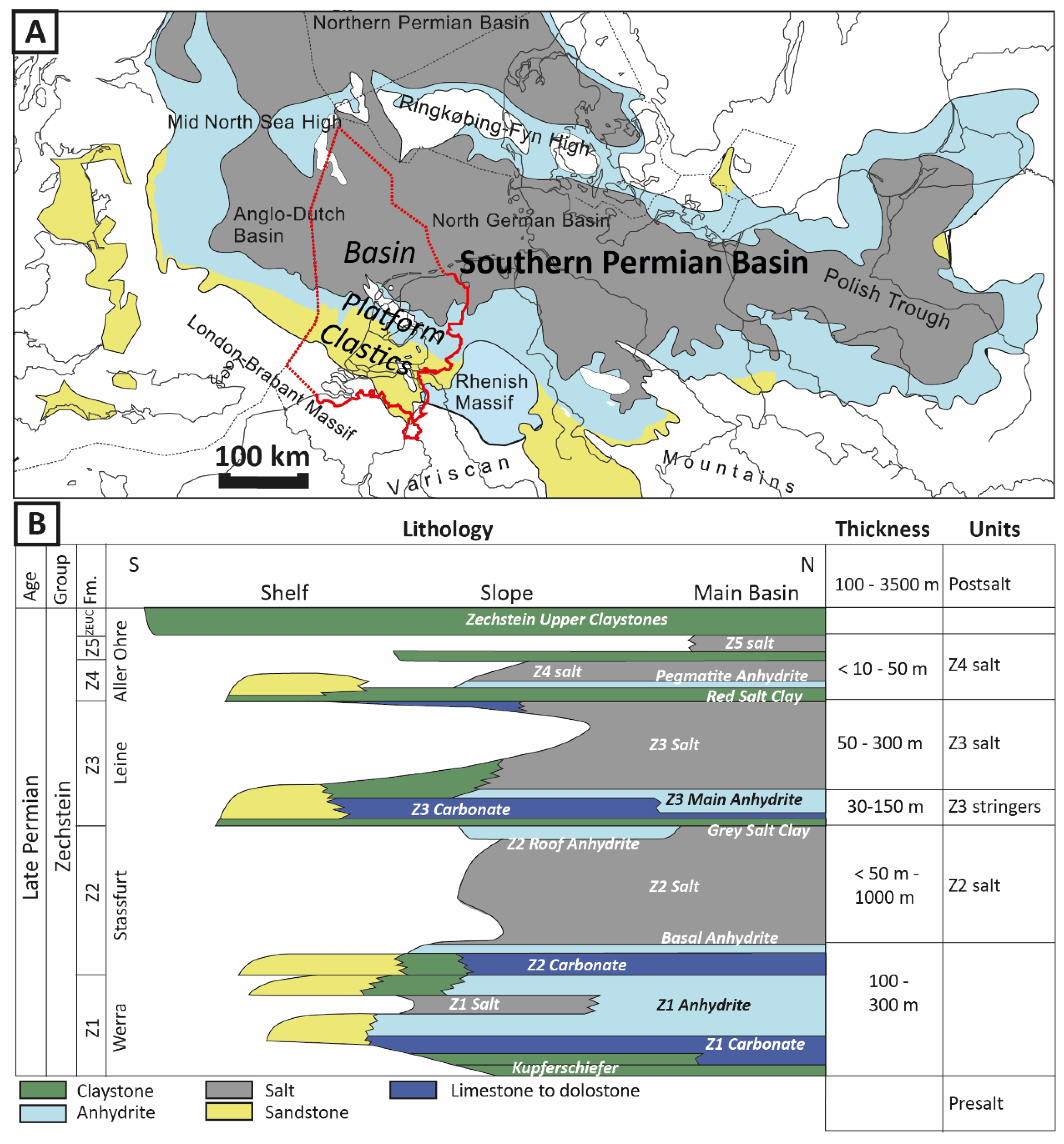

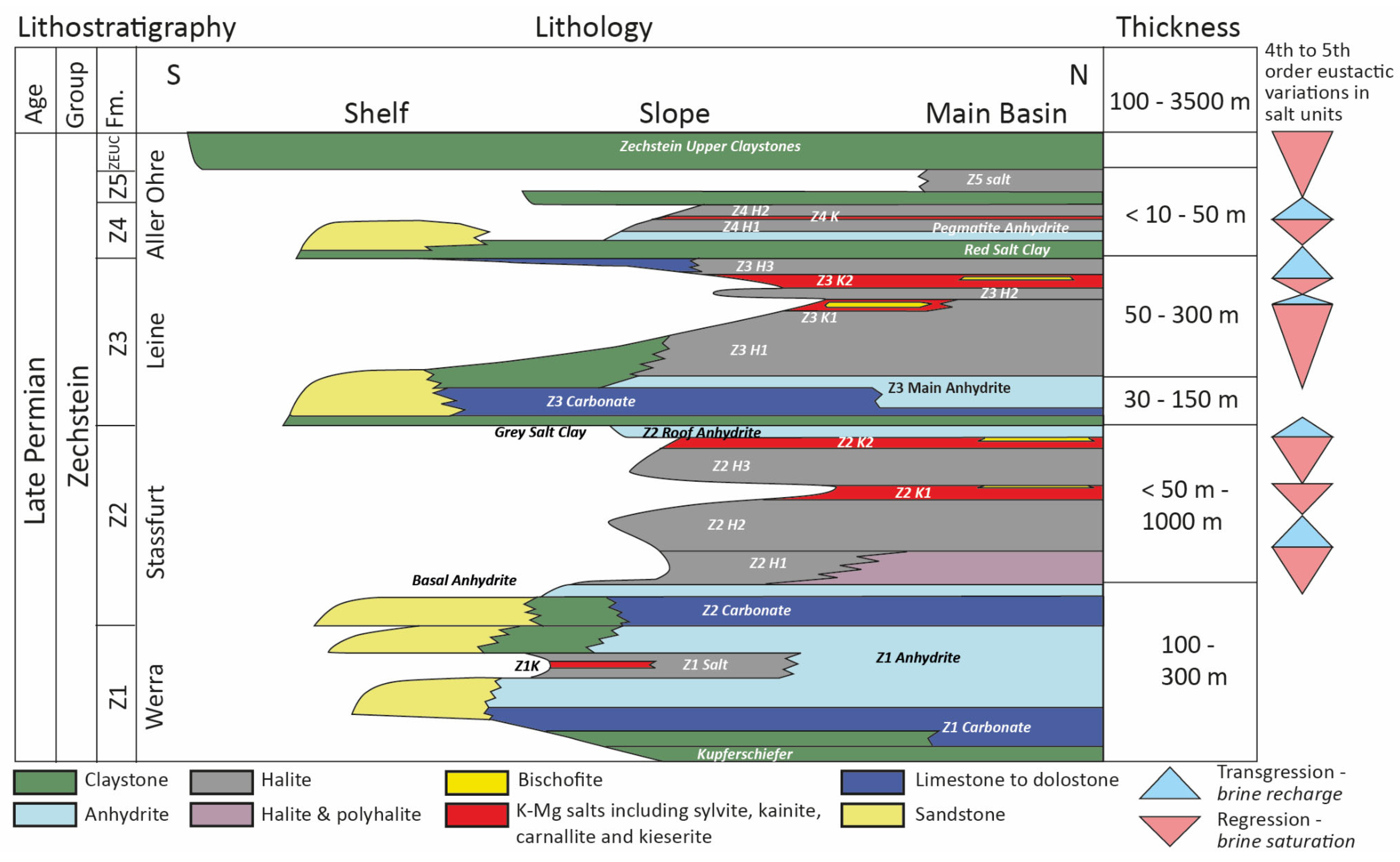
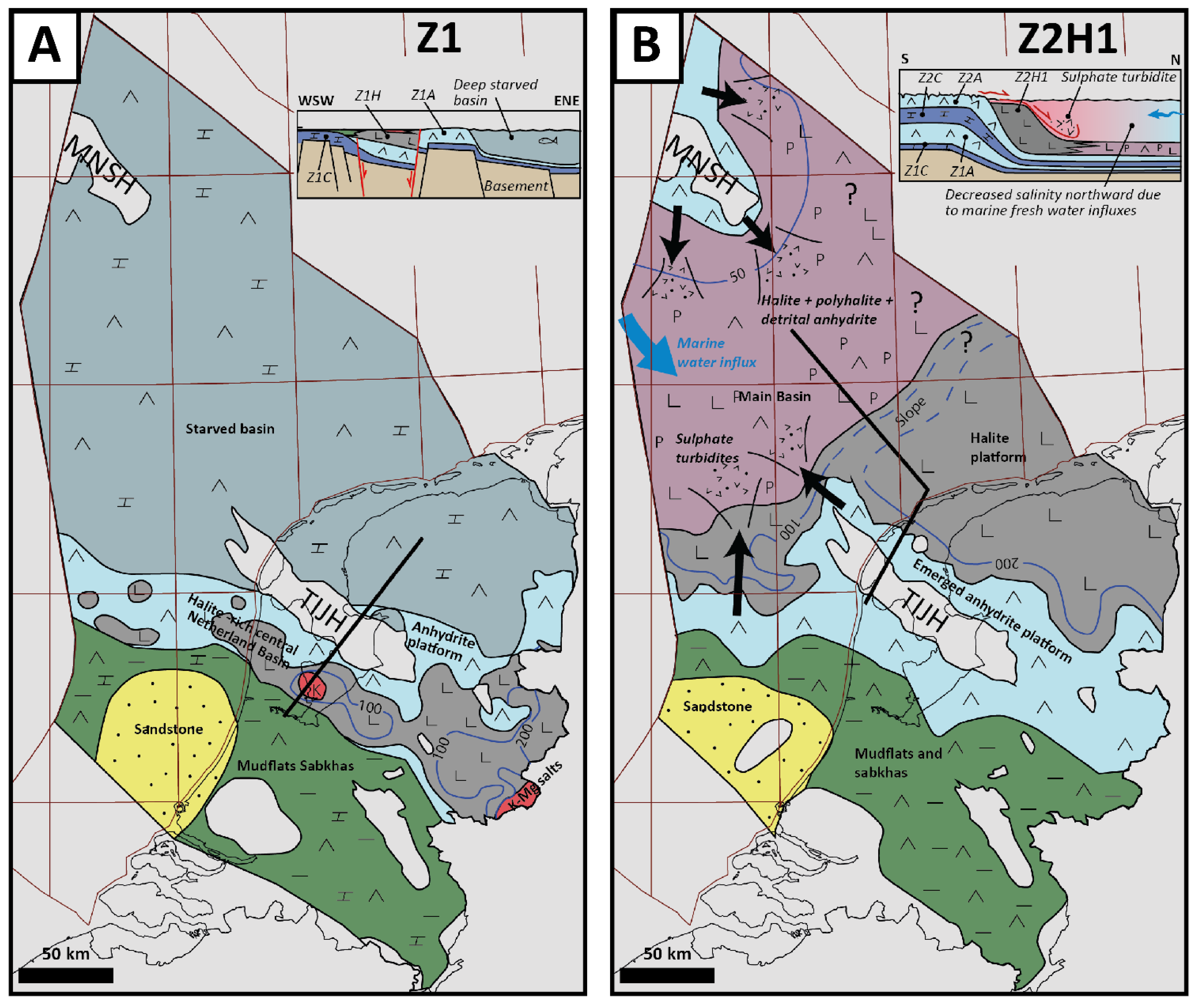
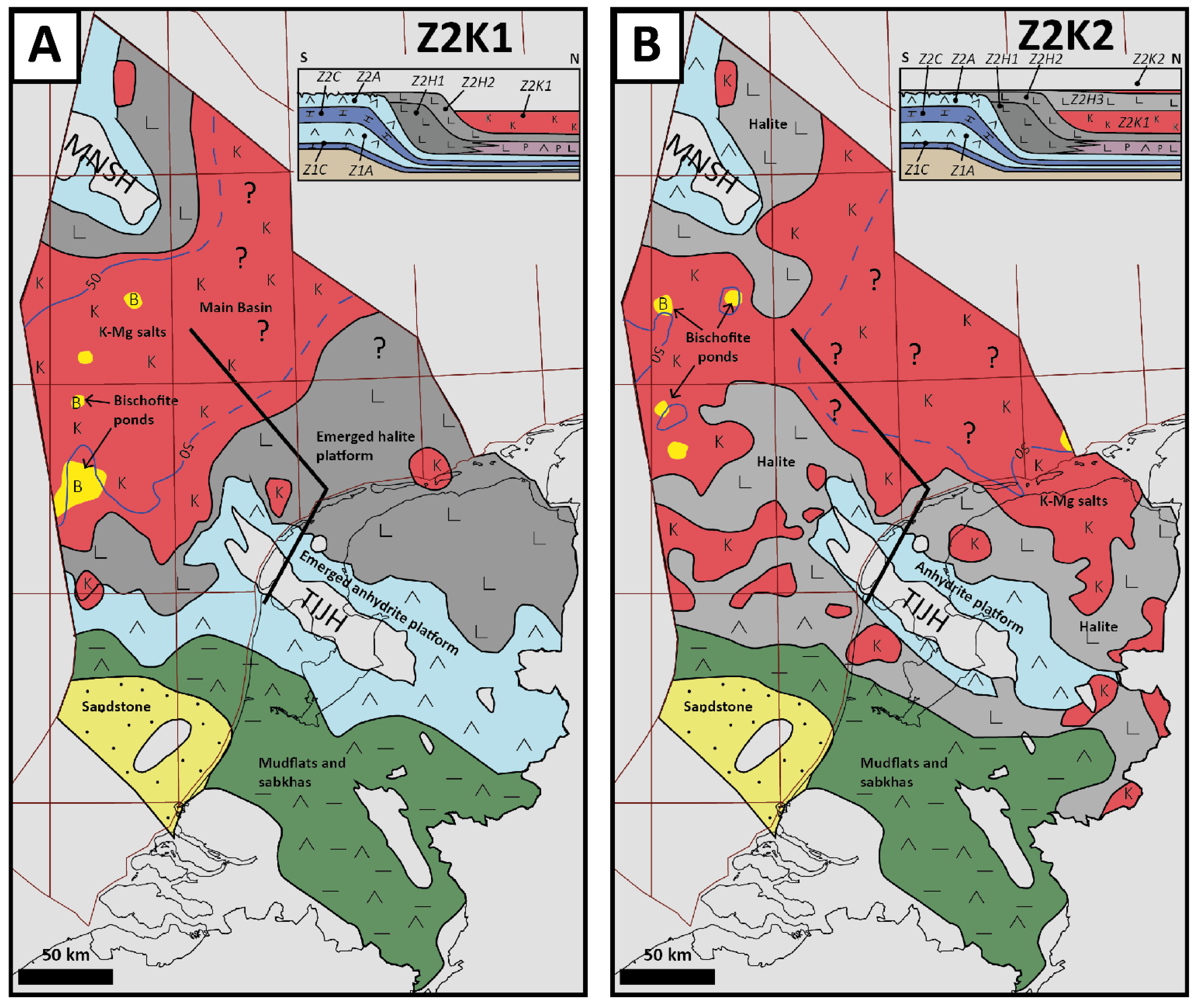
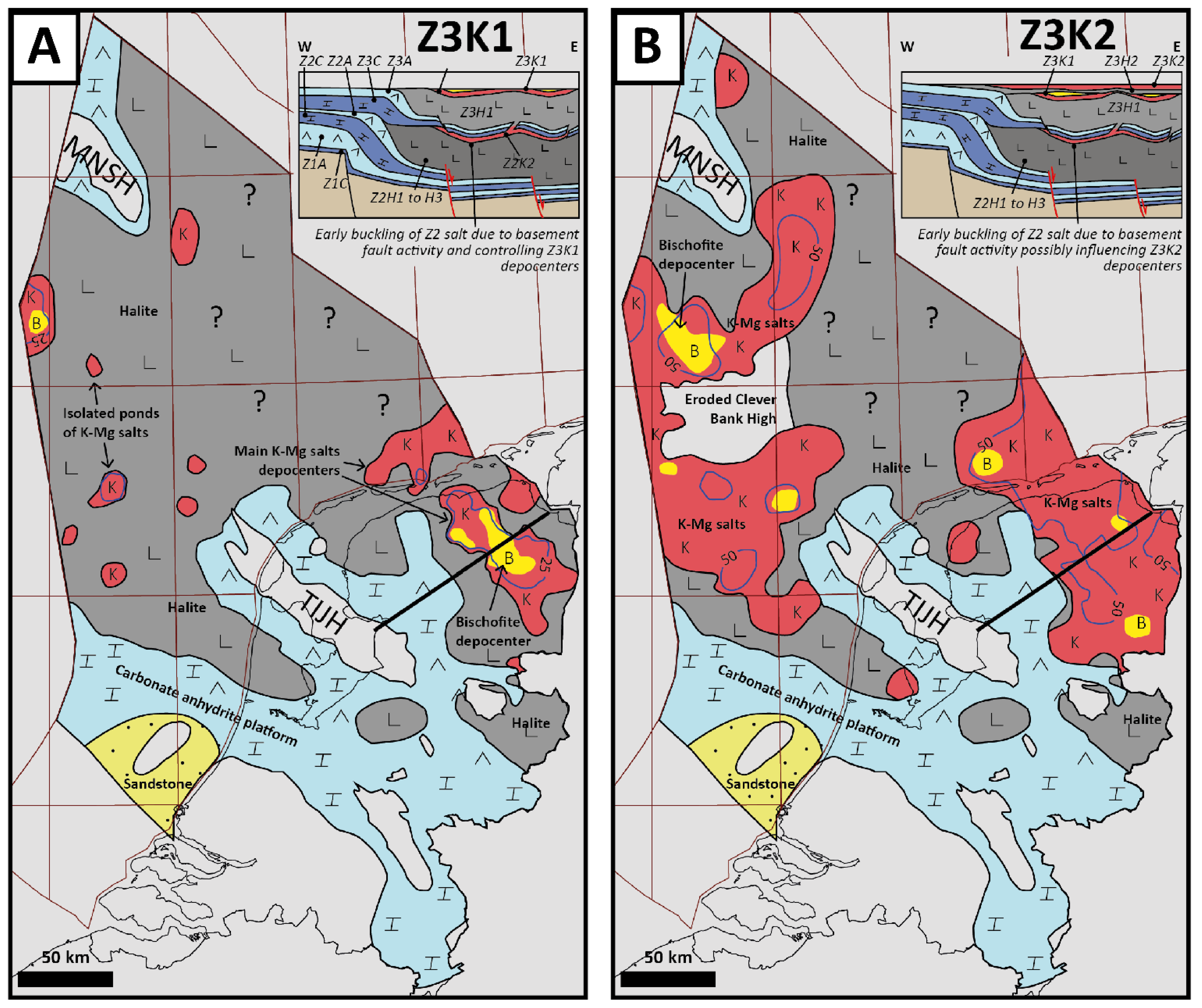
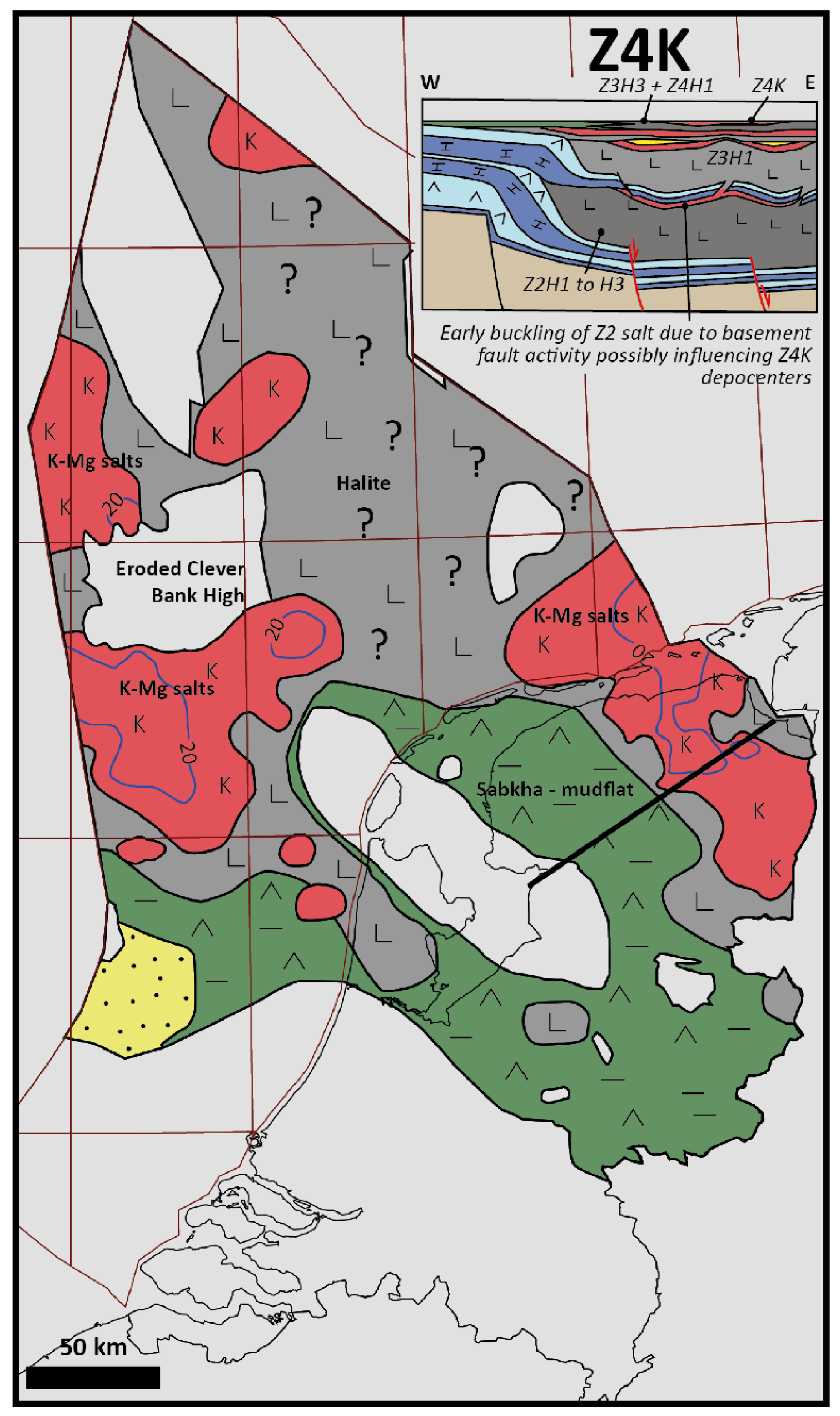

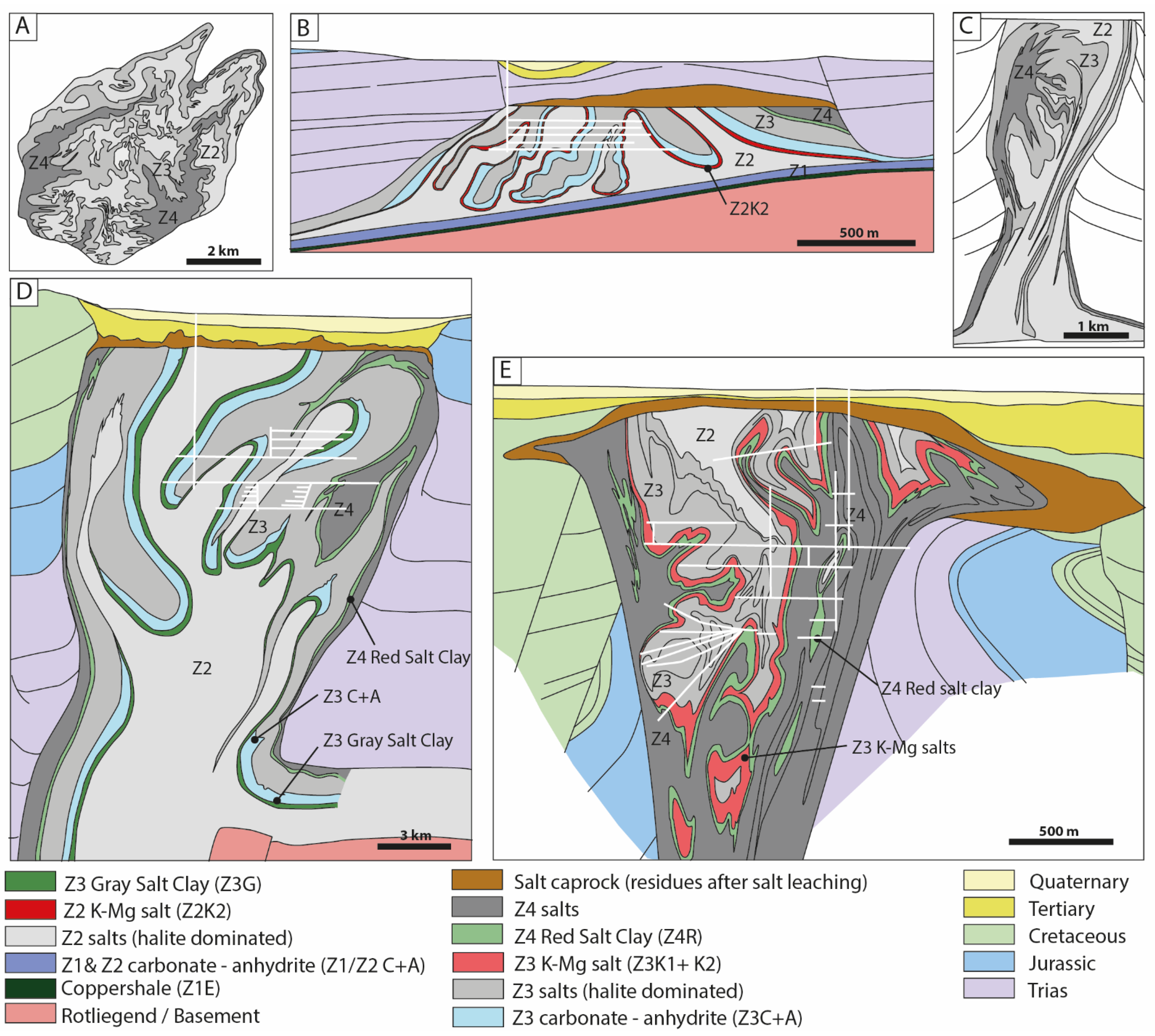
Publisher’s Note: MDPI stays neutral with regard to jurisdictional claims in published maps and institutional affiliations. |
© 2022 by the author. Licensee MDPI, Basel, Switzerland. This article is an open access article distributed under the terms and conditions of the Creative Commons Attribution (CC BY) license (https://creativecommons.org/licenses/by/4.0/).
Share and Cite
Pichat, A. Stratigraphy, Paleogeography and Depositional Setting of the K–Mg Salts in the Zechstein Group of Netherlands—Implications for the Development of Salt Caverns. Minerals 2022, 12, 486. https://doi.org/10.3390/min12040486
Pichat A. Stratigraphy, Paleogeography and Depositional Setting of the K–Mg Salts in the Zechstein Group of Netherlands—Implications for the Development of Salt Caverns. Minerals. 2022; 12(4):486. https://doi.org/10.3390/min12040486
Chicago/Turabian StylePichat, Alexandre. 2022. "Stratigraphy, Paleogeography and Depositional Setting of the K–Mg Salts in the Zechstein Group of Netherlands—Implications for the Development of Salt Caverns" Minerals 12, no. 4: 486. https://doi.org/10.3390/min12040486
APA StylePichat, A. (2022). Stratigraphy, Paleogeography and Depositional Setting of the K–Mg Salts in the Zechstein Group of Netherlands—Implications for the Development of Salt Caverns. Minerals, 12(4), 486. https://doi.org/10.3390/min12040486





